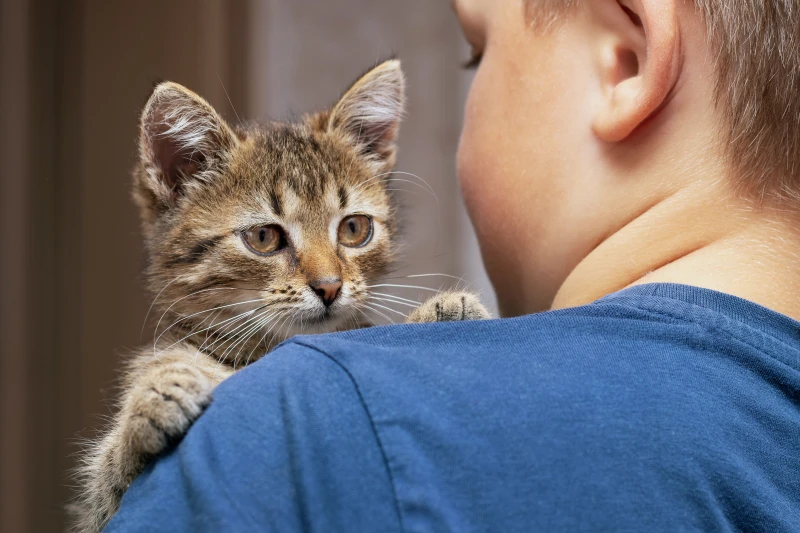People have been interested in cats, those mysterious and independent animals, for thousands of years. From being revered by the ancient Egyptians to becoming internet stars today, cats have grabbed our hearts and minds. Even though we’ve lived with them for a long time, the real level of their intelligence is still up for discussion. This article goes into detail about the ideas about how smart cats are by looking at their cognitive powers, ability to solve problems, and unique behaviors.
The Evolution of Feline Intelligence
Before we can understand how smart cats are, we need to look at how they evolved. Cats that live in homes are descended from wild cats, mostly the African wildcat (Felis silvestris lybica). Their cognitive skills have changed as they have gone from being solitary hunters to house pets. They are probably smarter because they have to deal with complicated social systems, hunt for food, and protect their territories.
Smarts for socializing
Cats are not loner animals as many people think. They may not get together in big groups like dogs do, but they still have complicated social behaviors. Cats may have some social intelligence because they can understand social hierarchies and form bonds with both people and other cats. Observing feral cat groups shows how complex their social structures are and how they work together to raise their young.
Ability to Solve Problems
How well an animal can solve problems and adjust to new settings is one way to measure its intelligence. Cats are very good at fixing problems, especially when it comes to getting food. Cats can move things around to get to food, use tools, and even understand basic mechanical ideas, according to studies. They seem to have some cognitive freedom because they can learn by making mistakes.
Knowing where you are and how to get around
Cats are known for having a great sense of direction and being able to get around very easily. Cats are naturally good at making maps of their surroundings and finding their way around complicated settings, according to research. Many of their sensory skills, such as their sharp eyesight, hearing, and highly developed sense of smell, help them understand space very well. Their ability to find their way home over long distances, even in places they have never been before, shows how good they are at navigation.
How people talk and write
Cats may not talk like people do, but they have a lot of different sounds, body language, and smell-marking ways to talk to each other. To understand what cats are saying, you have to carefully watch and think about what they do. Cats can show a lot of different feelings and goals through their sounds, like meowing, purring, hissing, and growling. Their body language, such as how their tail moves, where their ears are placed, and how they look, also tells you a lot about their mood and plans.
Having emotional intelligence
Cats are often seen as cold and independent, but they can form strong emotional bonds with the people they live with. Scientists have found that cats feel many different feelings, such as happiness, love, fear, and stress. They understand how people feel and can comfort and help people when they need it. Cats are very close to their owners, which shows how emotionally intelligent and empathetic they are.
Cultural and Environmental Influences
The intelligence of cats is also shaped by cultural and environmental factors. Different breeds may exhibit varying levels of intelligence and problem-solving skills. Furthermore, early experiences and socialization play a crucial role in shaping a cat’s cognitive development. Cats raised in enriched environments with opportunities for mental stimulation and social interaction are likely to exhibit greater intelligence and adaptability.
Studies that compare
When you compare cats’ intelligence to that of other animals, like dogs and monkeys, you can learn a lot about how smart they are. People usually think of dogs as more trainable and obedient, but cats are smart in their ways. Studies have shown that cats are better at tasks that require them to solve problems on their own and rely on themselves, while dogs are better at tasks that require them to work with others and obey. Understanding how cognitive skills vary between species shows how animals adapt to their surroundings in many different ways.
Memory and the ability to learn
Cats have great memories and can learn quickly, which helps them stay alive and adapt to different surroundings. Cats may be able to remember things like where resources are, what they learned, and how to do things for long amounts of time. Being able to remember things helps them find food, get around, and stay away from possible dangers. Cats can also learn by associating things, which means they can make links between stimuli and reactions by rewarding or punishing them. They can change to new situations and make smart choices based on what they’ve learned in the past because their minds are flexible.
How to Solve Problems in Play
There’s more to cats’ play than just having fun. It helps them learn how to solve problems and improve their skills. Cats get better at hunting, coordinating their movements, and thinking by playing with toys, games, and even other cats. Neuroplasticity is the brain’s ability to make new links between neurons and rearrange old ones. Playing is good for this. Cats not only keep their bodies healthy by playing, but they also keep their minds sharp, which gets them ready for challenges in their surroundings.
How our senses work and how we hunt
Cats use their sharp senses to find food quickly and effectively, showing that they have advanced sensory perception and smart hunting tactics. Because they have good eyesight, they can see things even when it’s dark outside, which makes them very good at hunting at night. In addition to being able to see well, cats can also hear very well and can find their food just by hearing it. Their sensitive whiskers also help them find their way around small areas and notice changes in airflow. Cats use different hunting strategies, like watching, ambushing, and pouncing, to catch their prey which is hard to catch because they use information from many senses at once. Looking at how cats hunt gives us clues about their senses and how well they can solve problems, which helps us understand how smart cats are.
Conclusion
How smart cats are is a complicated and interesting topic that continues to interest both experts and cat lovers. Cats have a lot of interesting cognitive skills that should be studied further. For example, they are very good at fixing problems and have complicated social behaviors. By looking into the ideas about how smart cats are, we can better understand these mysterious animals and the unique ways they connect with the world around them. We will continue to learn more about how cats think and feel, and that will make us appreciate their intelligence and complexity even more.



